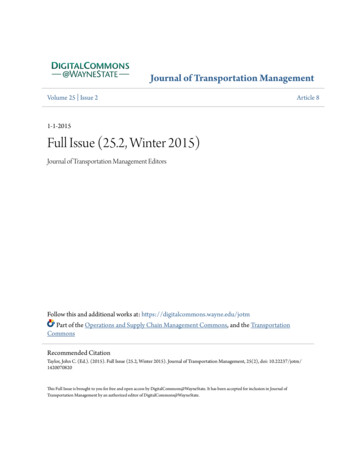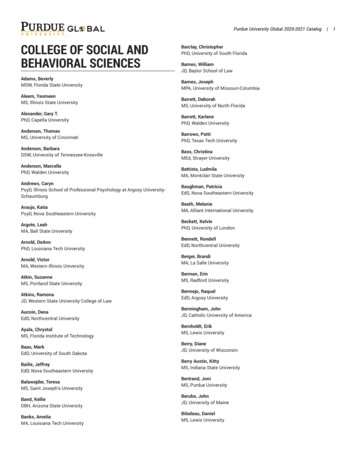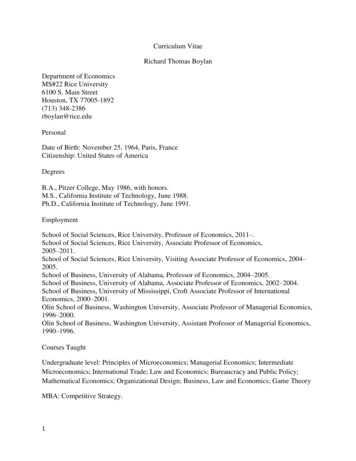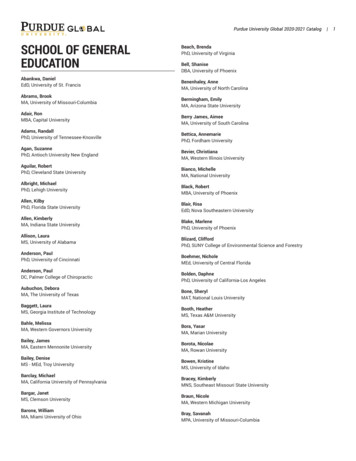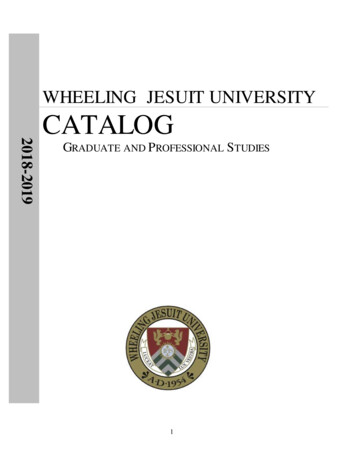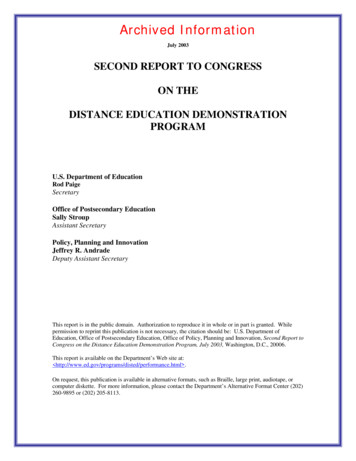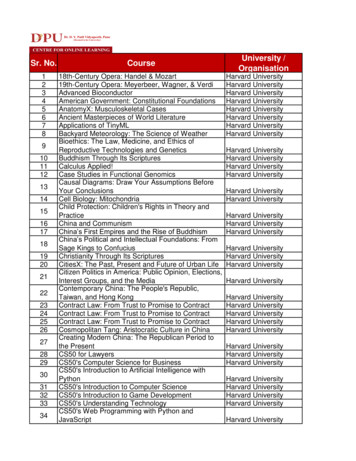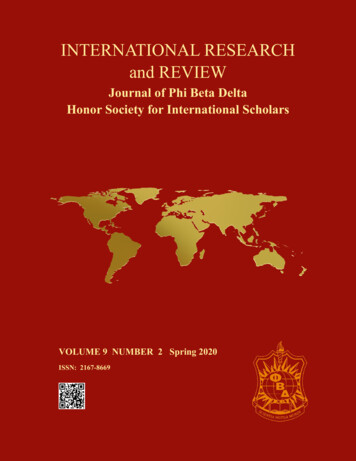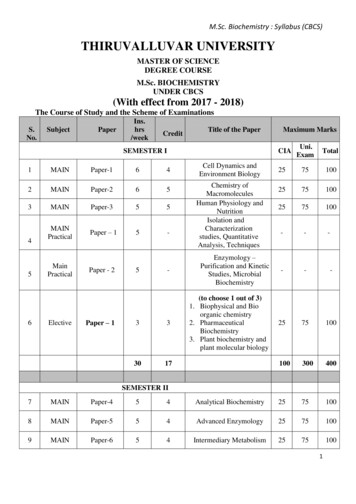
Transcription
M.Sc. Biochemistry : Syllabus (CBCS)THIRUVALLUVAR UNIVERSITYMASTER OF SCIENCEDEGREE COURSEM.Sc. BIOCHEMISTRYUNDER CBCS(With effect from 2017 - 2018)The Course of Study and the Scheme of le of the PaperSEMESTER ticalPaper – 15-56MainPracticalElectivePaper - 2Paper – 1Cell Dynamics andEnvironment BiologyChemistry ofMacromoleculesHuman Physiology andNutritionIsolation andCharacterizationstudies, QuantitativeAnalysis, Techniques-Enzymology –Purification and KineticStudies, MicrobialBiochemistry33(to choose 1 out of 3)1. Biophysical and Bioorganic chemistry2. PharmaceuticalBiochemistry3. Plant biochemistry andplant molecular -2575100100300400CIA14Maximum Marks-SEMESTER II7MAINPaper-454Analytical Biochemistry25751008MAINPaper-554Advanced Enzymology25751009MAINPaper-654Intermediary Metabolism25751001
M.Sc. Biochemistry : Syllabus (CBCS)51011MAINPracticalMAINPractical5Paper - 155Paper - 2Isolation andCharacterization studies,Quantitative Analysis,TechniquesEnzymology – Purificationand Kinetic Studies,Microbial Biochemistry(to choose 1 out of 3)12Elective13CompulsorypaperPaper – 2331. Microbiology2. DiagnosticBiochemistry3. Biochemical andEnvironmental22Human .CIA Exam TotalSEMESTER III14MAINPaper-765Advanced Endocrinology257510015MAINPaper-865Research Practical-45-ElectivePaper - 333257530181003001819Biochemical analysis ofblood, Immunological andMolecular BiologytechniquesHaematological methods,Urine analaysis(to choose 1 out of 3)1. Immunology2. Bioinformatics3. Nano biotechnology1004002
M.Sc. Biochemistry : Syllabus (CBCS)Molecular Biology25Uni.Exam75Advanced ClinicalBiochemistry2575100150200SEMESTER IV20MAIN21MAINPaper-10Paper – 35524MainPracticalPaper – 45524ElectivePaper - 433Subject50Biochemical analysis ofblood, Immunological andMolecular Biologytechniques25751002575100Hametological methods,Urine analysis(to choose 1 out of 3)Stem cell technologyHerbal TechnologyGenetic Engineering28Papers Credit100Project / Dissertation withViva 251007003
M.Sc. Biochemistry : Syllabus (CBCS)THIRUVALLUVAR UNIVERSITYM.Sc. BIOCHEMISTRYSYLLABUSUNDER CBCS(With effect from 2017-2018)SEMESTER IPAPER-1CELL DYNAMICS AND ENVIRONMENTAL BIOLOGYUNIT-I : CELLULAR ORGANIZATION, DIVISION AND CYTOSKELETONSCell types - organization of prokaryotic and eukaryotic cells, cell division - mitosis andmeiosis, cell cycle - phases of cell cycle, and regulation of cell growth and cell cycle, cellmotility - molecular motors, microtubules, structure and composition, micro tubularassociated proteins - role in intracellular motility.UNIT-II : CELLULAR ORGANELLES, CELLULAR COMMUNICATION ANDTRANSPORTCellular organelles – morphology and function. Differentiation of cell membrane microvilli, epithelia, Bell and sqot desmosomes - mechanical function, cell-cell interaction,cell adhesion proteins, cell junctions, tight junction and gap junction, cell surface of plantcells and cancer cells.Overview of membrane protein - peripheral and integral, molecular model of cell membrane- fluid mosaic model and membrane fluidity, solute transport across membrane - passivetransport, active transport by ATP powered pumps, types of transport systems.UNIT-III : ENVIRONMENT AND ECOLOGICAL SUCCESSIONPhysical environment – Biotic and abiotic environment; concept of habitat and niche, nichewidth and overlap, fundamental and realized niche, resource partitioning, characterdisplacement. Ecological succession - types, mechanisms, and changes involved insuccession.4
M.Sc. Biochemistry : Syllabus (CBCS)UNIT-IV : POPULATION ECOLOGY & ORIGIN OF CELLSCharacteristics ofa population, population growth curves, population regulation, life historystatergies ( r and k selection). Concept of metapopulation – demes and dispersal, interdemicextinctions, age structured populations. Origin of basic biological molecules; abioticsynthesis of organic monomers and polymers; concept of oparin and Haldane, experiment ofmiller. Evolution of prokaryotes and eukaryotes.UNIT V : PALEONTOLOGY , EVOLUTIONARY HISTORY AND MOLECULAREVOLUTIONThe evolutionary time scale, eras, periods and epoch; major events in theevolutionary time scale.Concepts of neutral evolution, molecular divergence andmolecular clocks; molecular tools in phylogeny, classification and identification;Convergent evolution, sexual evolution and co-evolution.References1. The World of the cell - Becker, Kleinsmith and Harden Academic Internet Publishers;5th edition 2006.2. The Cell: A Molecular Approach, Fourth Edition- Geoffrey M. Cooper and RobertE. Hausman.3. Cell and Molecular Biology by concepts and experiments - Gerald Karp John Wileysons & Inc, - 2005.4. Molecular cell Biology - Harvey Lodish. W. H. Freeman; Sol edition, 2007.5. The Cell - Biochemistry, physiology and morphology - J. Brachet and A. E. Mirsky,Academic Press, 1963.5
M.Sc. Biochemistry : Syllabus (CBCS)PAPER-2CHEMISTRY OF MACROMOLECULESUNIT-I: HOMO AND HETEROGLYCANSPolysaccharides - occurrence, structure, properties and functions of homoglycans - starch,glycogen, cellulose, dextrin, inulin, chitins. Occurrence, structure, properties, and functionsof heteroglycans - bacterial cell wall polysaccharides, glycoaminoglycans, agar, alginic acid,pectins, amino sugars and deoxy sugars, blood group substances and sialic acids.Glycoprotein and their biological applications. Lectins structure and functions.UNIT-II: AMINOACIDS AND PROTEINSClassification, properties and function of aminoacids and proteins.Primary structure determination of amino acid sequence of proteins. The peptide bond: Ramachandran plot.Secondary structure - weak interactions involved - alpha helix and beta sheet and beta turnsstructure. Collagen triple helix. Super secondary structures - helix-loop-helix. Tertiarystructure - alpha and beta domains. Quaternary structure - structure of hemoglobin.UNIT-III : NUCLEIC ACIDSWatson - Crick model of DNA structure. A, B and Z - DNA Cruciform structure in DNA,formation and stability of cruciforms, miscellaneous alternative conformation of DNA,slipped mispaired DNA, parallel stranded, anisomorphic DNA, palindrome.Types of RNA,hnRNA, methods for nucleic acid sequence determination, denaturation and renaturation,Cot value curve, hypochromic effect, DNA-protein interactions.UNIT-IV : LIPIDSLipids - classification, phospholipids - classification, structure and functions. Ceramides andsphingomyelins. Eicosanoids, structure and functions of prostaglandins, thromboxanes,leukotrienes Types and functions of plasma lipoproteins. Amphipathic lipids - membranes,micelles, emulsions and liposomes. Steroids - cholesterol structure and biological role - bileacids, bile salts.UNIT-V : VITAMINSVitamins - water soluble - thiamine, riboflavin, niacin, pyridoxine, folic acid, ascorbic acidsources, structure, biochemical functions, deficiency diseases, daily requirements; fatsoluble - vitamin A, vitamin D, vitamin E and vitamin K - sources, structure, biochemicalfunctions, deficiency diseases, daily requirements.References1. Biochemistry -L. Stryer, W.H. Freeman and Co, 5th 2002.2. Fundamentals of Biochemistry - Voet and Voet, John Wiley and sons NY, 2002.3. Lehninger’s Principle of Biochemistry -David L. Nelsonand Michael M. Cox. W. H.Freeman; 4th edition, 2004.4. Text Book of Biochemistry with clinical correlation - Thomas .M. Devlin, John WileyLiss, Hobokhen NJ publishers, 2006.5. Biochemistry - Zubey, GL WCB Publishers.6
M.Sc. Biochemistry : Syllabus (CBCS)PAPER-3HUMAN PHYSIOLOGY AND NUTRITIONUNIT-I : DIGESTION, ABSORPTION AND EXCRETIONDigestive secretions - composition, functions and regulation of saliva, gastric, pancreatic,intestinal and bile secretions. Digestion and absorption of carbohydrates, lipids and proteins.Excretory system - structure of nephron. Formation of urine - glomerular filtration, tubularreabsorption of glucose, water and electrolytes, tubular secretion.UNIT-II : BLOOD AND CIRCULATIONComposition and functions of blood and plasma. Blood groups. Blood coagulation mechanism, fibrinolysis. Hemoglobin - structure, abnormal types, anemia. Structure ofheart, cardiac cycle, heart sounds, E.C.G (elementary knowledge), blood pressure, spleen,lymph, normal composition and function of lymph - role of different lymph cells.UNIT-III : RESPIRATION AND REPRODUCTIONStructure of lungs, mechanism and regulation of respiration. Transport of blood gases - O2and CO2. Acid-base balance - role of buffers, erythrocytes, respiratory system and kidneys.Acidosis and alkalosis - metabolic and respiratory. Fluid electrolyte balance - regulation ofwater balance and sodium balance - role of renin-angiotensin and ADH.Structure and function of reproductive organs, composition of semen, physiology ofpregnancy, parturition and lactation.UNIT-IV : NEUROMUSCULAR FUNCTIONStructure and function of nerves, neurons, resting and action potential, transmission of nerveimpulses, synaptic transmission, compounds affecting synaptic transmission, neuromuscularjunction. Structure of muscle cells and muscle contraction, molecular organization ofmuscle, proteins of contractile element - their organization and role in contraction, energyfor contraction.UNIT-V : NUTRITIONBasal metabolism, basal metabolic rate, factors affecting BMR, determination of BMR direct and indirect method, respiratory quotient. Role of fiber in diet, role of essential aminoacids - relation with Marasmus, Kwashiorkar disease, role of essential fatty acids, disordersof fatty acid metabolism, Refsum’s disease. Trace elements - macro and micro, dailyrequirements, functions, deficiency manifestations. Nutrition at different stages of life during infancy, adolescence, pregnancy and old age.References1. Review of Medical Physiology - William. F. Ganong. McGraw-Hill Medical; 22 edition,2005.2. Human Physiology and Mechanisms of Disease - Guyton. Saunders Publications; 6thedition, 1996.3. Human physiology - C.C. Chatterjee. 11th edition, 1985.4. Human Nutrition and Dietetics - Davidson and Passmore. Churchill Livingstone; 8thedition, 1986.5. Principles of Nutrition - M.S.Swaminathan6. Modern Nutrition and Health Diseases - M.E. Skilis and V.R. Young7
M.Sc. Biochemistry : Syllabus (CBCS)ELECTIVEPAPER-1(To choose 1 out 3)A. BIOPHYISCAL AND BIOORGANIC CHEMISTRYUNIT-I : BIOENERGETICSThermodynamics - basic concepts. First, second and third laws of thermodynamics enthalpy and entropy, exothermic and endothermic reactions. Free energy - standard freeenergy. Temperature and pressure dependence of free energy. Equilibrium for biochemicalreactions. High energy phosphates and free energy. Redox reactions and free energychanges in biological reactions.UNIT-II : SPECTROSCOPY AND STRUCTURAL ELUCIDATIONThe electromagnetic spectrum - quantization of energy. Regions of the spectrum. Basicprinciples of UV, NMR and mass spectrometry and their biological applications. FT-NMRNuclear overhauzer effect. Use of X-ray crystallography and CD in the study of proteins andnucleic acids.UNIT-III : ATOMIC STRUCTURE AND CHEMICAL BONDSAtomic orbitals. quantum numbers. Shapes of s, p and d orbitals. Aufbau principle, Pauliexclusion principle and Hund’s rule. Electronic configuration of atoms, formation ofchemical bonds, octet rule, ionic bond, covalent bond and co-ordinate bonds with examples.UNIT-IV : FUNCTIONAL GROUPS AND REACTIONSClassification of organic compounds based on functional groups and their nomenclature.Biologically important organic compounds (names and structures). Hemolytic andheterolytic cleavage of covalent bonds. Reactive species: electrophiles, nucleophiles andradicals. Types of organic reactions with examples. Inductive effect and resonance.UNIT-V : ISOMERISMIsomerism in organic compounds. Types of isomerisms, tautomerism with special referenceto lactic acid.Stereoisomerism. Geometric isomerism with special reference to maleic acid andunsaturated fatty acids. Partial double bond character of C-N bonds in amides. Geometricalisomerism in such compounds.Optical isomerism, optical activity, enantiomers, diastereomers. Meso and dl forms. R-S andD-L notations in amino acids and sugars. Conformational analysis, conformations of ethaneand cyclohexane.8
M.Sc. Biochemistry : Syllabus (CBCS)B. PHARMACEUTICAL BIOCHEMISTRYUNIT-IDrug - Structural feature and pharmacology activity, prodrug concept. Absorption -first –pass effect. Distribution, metabolism- Phase I, II reactions, action of cytochrome p450 &elimination of drug receptor- localization, type and subtypes, models and their drug –receptor interaction, agonist & antagonist.UNIT-IIAdverse response to drugs, Drug tolerance, Drug intolerance, Idio syneracy(pharmacogenesis), drug allergy. Tachyphylaxis, Drug abuse, vaccination against infection,factor that modifies the effect of drug. Assay of drug potency- bioassay and immunoassay.UNIT-IIIBiotechnology and pharmacy: Genetically engineered protein and peptide agents. Noveldrug delivery systems – non conventional routes of administration. Anti-AIDS drugdevelopment, oncogenes ras target for drugs, multi-drug resistance.UNIT-IVMechanism of action of drugs used in therapy of: Respiratory system – cough, bronchial –asthma, pulmonary tuberculosis. GIT – Digestants, appetite suppressants. Hypolipidemiaagents, vomiting, constipation and peptic ulcer. Antimicrobial drugs – sulfonamides,trimethoprim, cotrimoxazole, penicillin, and macrolides. Aminoglycosides, Cephalosporinand bacterial resistance. Insulin and oral diabetic drugs, antifertility and ovulationinducingdrugs.UNIT-VDrugs of plant origin: Drug dependence and abuse – Management of self poisoning cancer.Chemotherapy – Cytotoxic drug. Immuno suppressive drug therapy. New BiologicalTargets for Drug Development. Novel Drug Screening Strategies.References:1. The pharmacology Vol I and II- Goodman And Gillman, Mc Graw Hill2. Basic pharmacology- Foxtercox Bulter Worth’s, 1980.3. Pharmacology and pharmacotherapeutics- R.S.Satoskar. S.D.Bhandhakar &S.S.Anilapure Popular Prakashar Bombay.4. Principles of medicinal chemistry- William O. Foge.B.I. Waverks Pvt Ltd, NewDelhi.5. Oxford textbook of clinicasl pharmacology and drug therapy. D.G. Burger’smedicinal Chemistry & Drug Discovery.6. Principles and practice- Manfred.E. Wolf John Wiley and sons9
M.Sc. Biochemistry : Syllabus (CBCS)ELECTIVEPAPER-4(to choose 1 out 3)C. PLANT BIOCHEMISTRY AND PLANT MOLECULAR BIOLOGYUNIT-I : ENERGY GENERATING MECHANISMPhotosynthetic Pigments, Light and Dark reactions of photosynthesis. Proton gradient andATP synthesis of chloroplast and Bacterium. Mode of action of DCMU, Regulation ofphotosynthesis, Bacterio rhodopsin, CAM metabolism, RUBISCO, photorespiration andcrop productivity.UNIT-II: NITROGEN METABOLISM AND PLANT HORMONESNitrogen cycle, biochemistry of Symbiotic and Nonsymbiotic nitrogen fixation.Assimilation of ammonium , carbon-nitrogen ratio, Uride metabolism, nitrate metabolism,genetics of nitrogen fixation, genetic manipulation of Nif genes, Biosynthesis, Mode ofaction, transport, distribution and physiological effect of Auxin, Giberrilin, Cytokinin, Abaand ethylene.UNIT-III : PLANT DISEASE AND SECONDARY METABOLITESBiochemistry of plant disease, defence mechanism of plants, biosynthesis, distribution andbiological functions of industrially important secondary metabolite, (Any 10) Principles ofplant disease control.UNIT-IV : PLANT PHYSIOLOGYWater relations of plant, Mechanism of water absorption. Aquaporin Symplast - Apoplastconcept. Ascent of sap, Transpiration and Stomatal mechanism. Source and sinkrelationship, Translocation of Inorganic and Organic substances, Bud and Seed dormancy.Senescence, Stress response in plant, Phytochromes- Properties, Photochemicals,transformation, Mode of action and physiological effect.UNIT-V : PLANT MOLECULAR BIOLOGY AND BIOTECHNOLOGYDNA polymorphism – Importance of RFLP and RAPD in plant breeding management.Aspects of plant genetic engineering. Tacking, Mapping and Cloning of plant genes,Selectable markers. Reporter genes and promoters used in plant vectors. Ti plasmids andCrown gall tumor, Genetic engineering of plant for disease resistance, Cytoplasmic MaleSterility, Edible oil, Biodegradable plastics, Delay of fruit ripening. Methods andApplication of plant tissue culture.10
M.Sc. Biochemistry : Syllabus (CBCS)Text Books:1. Modern Plant Physiology - R.K. Sinha, Narosa Publishing House, 2004.2. Microbiology – M.J. Pelczar, E.C.S. Chan and N.R. Kreig, Tata McGraw HillPublishing Co., 5th Edition, 1986.3. Microbiology – L.M. Prescott, J.P. Harley and D.A. Klein, McGraw Hill, 6th Edition,2004.References:1. Introduction to Plant Biochemistry – T.W. Goodwin, Pergamon Press, 1986.2. Plant Biochemistry and Molecular Biology – P.J. Lea, L.L. Castle and Lea, 2ndEdition, John Wiley & Sons, 1999.3. Microbiology – B.D. Davis, R. Dulbecco, H.N. Eisen and H.S. Ginsberg. 3rd Edition,Harper & Row, 1980.11
M.Sc. Biochemistry : Syllabus (CBCS)SEMESTER IIPAPER-4ANALYTICAL BIOCHEMISTRYUNIT I - ELECTROCHEMICAL TECHNIQUES AND ELECTROPHORESISElectrochemical techniques – principles, electrochemical cells – pH, Henderson –Hasselbalch equation, buffer capacity, pH measurement, glass electrode. Oxygen electrode– principle and application. Biosensors.Separation of DNA fragments – Pulsed field gel electrophoresis. Autoanalyser – principal,instrumentation and applications. Isoelectric point-2D gel electrophoresisUNIT II - ENZYME ASSAY, CENTRIFUGATION AND RADIOCHEMICALTECHNIQUESEnzyme monitoring technique – Assay methods, Immobilized enzymes.Centrifugation: Preparative and Analytical ultracentrifuges.Radiochemical methods – Basis concepts, counting methods and application.Autoradiography.UNIT III – CHROMATOGRAPHY AND SPECTROSCOPY TECHNIQUESGC, HPLC – principle, components, limitations and applications.HPTLC – technique and applicationsOptical rotatory dispersion, Circular dichroism, X-ray diffraction, Nuclear magneticresonance, Electron spin resonance and Mass spectrometry – basic principle and applicationprinciple and applications of trubidimetry and nephelometry. Flow cytometry and cellseparation.UNIT IV – MOLECULAR TECHNIQUESRestriction endonucleases, Restriction mapping, Nucleic acid probes – cloned probes,oligonucleotide probes and labelling of nucleic acid probs. Membrane blotting andhybridization of nucleic acids – Southern, Northern, Western, dot-plot and Fluorescentinsitu hybridization. RFLR – Technique & applications.PCR basic principle, technique, diagnostic and laboratory applications of PCR, RAPDConstruction of DNA and Oligonucleotide microarray.UNIT V–MOLECULAR MARKERS ANALYSISDiagnostic applications of nucleic acid probes – sickle cell anaemia, thalassemia,haemophilia and lymphoid malignancy. Mutagenicity testing – Ames test. Comet assay andDNA fragmentation assay. Identifying protein – DNA interactions – DNA foot printing,DNA finger printing – Technique and applications. HLA typing – applications.12
M.Sc. Biochemistry : Syllabus (CBCS)REFERENCES1. Keith Wilson and John Walker - Principles and techniques of Biochemistry andMolecular Biology, Cambridge University Press, 6th Edition,2006.2. Boyer R. - Experimental Biochemistry, Addison Wesley, 3rd Edition, 2002.3. Bernard R. Glick and Jack.J. Pasternak - Molecular Biotechnology, ASM PressWashington 3rd Edition, 2003.4. D W Brown - Organic Spectroscopy, Wiley New York 1st Edition, 1998.5. M.Valcatcel - Principles of analytical chemistry-A Text book. Springer, 2000.6. David James Holme and Hazel Pack - Longman, 1994.13
M.Sc. Biochemistry : Syllabus (CBCS)PAPER-5ADVANCED ENZYMOLOGYUNIT-I : CLASSIFICATION, PURIFICATION AND ACTIVE SITENomenclature and classification of enzymes, isolation and purification of enzymes –enzymeprotein determination by different methods, criteria of purity - specificactivity.Enzyme units - Katal, IU. Measurement of enzyme activity - two point assay,kinetic assay, using radiolabelled substrates. Active site - determination of active site aminoacids - chemical probe, affinity label, and site-directed mutagenesis, intrinsic and extrinsicregulations.Investigation of 3-D structure of active site.A brief account of nonproteinenzymes - ribozymes and DNA enzymes.UNIT-II : ENZYME KINETICSKinetics of single substrate enzyme - catalysed reactions - Michaelis - Menten equation,importance of Vmax, Km, MM equation, and turnover number; Lineweaver - Burk plot,Eadie - Hofstee plot, and Hanes - Woolf plot .Presteady - state kinetics and relaxation kinetics.Kinetics of Allosteric enzymes - MWC andKNF models Hill’ equation coefficient. Kinetics of multi - substrate enzyme - catalysedreactions - Ping-pong bi-bi, random order and compulsory order mechanism.UNIT-III : ENZYME CATALYSIS AND INHIBITIONMechanism of enzymicaction , mechanism of serine proteases - chymotrypsin, lvsozyme,carboxy peptidase A and ribonuclease.Reversible inhibition - competitive, uncompetitive, noncompetitive, mixed, substrate andallosteric inhibition.Irreversible inhibition.UNIT-IV : COENZYMES AND ISOENZYMESCoenzymes - prosthetic group, classification - vitamin and nonvitamin coenzymes, thiaminepyrophosphate - mechanism of oxidative and nonoxidative decarboxylation, transketolasereaction, PALP and PAMP - role of PALP in transamination and decarboxylation reaction,folate coenzymes and vitamin C, metabolite and nonvitamin coenzymes, lipoic acid,coenzyme Q, nucleoside triphosphate and S-adenosyl methionine. Isoenzymes.14
M.Sc. Biochemistry : Syllabus (CBCS)UNIT-V : INDUSTRIAL AND CLINICAL USES OF ENZYMESIndustrial uses of enzymes - sources of industrial enzymes, thermophilic enzymes,amylases, glucose isomerases, cellulose degrading enzymes, lipases, proteolytic enzymes inmeat and leather industry, detergents and cheesed agents,anti-inflammatoryagents.Immobilization of enzymes and their applications.References1. Enzymes - Dixon and Webb, Academic Press, 19642. Understanding enzymes - Palmer. Prentice Hall; 4 Sub edition, 19953. Enzymes - Boyer. Academic Press; 3rd edition, November 19834. Biochemistry - Metzler. Academic Press, 2000.5. Biochemistry - Stryer. W. H. Freeman; 6 edition, 2006.15
M.Sc. Biochemistry : Syllabus (CBCS)PAPER-6INTERMEDIARY METABOLISMUNIT-I : BIOENERGETICS AND BIOLOGICAL OXIDATIONFree energy and entropy.Phosphoryl group transfers and ATP. Enzymes involved in redoxreactions. The electron transport chain - organization and role in electron capture.Oxidative phosphorylation - Electron transfer reactions in mitochondria. F1F0 ATPase Structure and mechanism of action. The chemiosmotic theory.Inhibitors of respiratory chainand oxidative phosphorylation - Uncouplers and ionophores.Regulation of oxidativephosphorylation.Mitochondrial transport systems - ATP/ADP exchange, malate / glycerophosphae shuttle,creatine - phosphate shuttle.UNIT-II : CARBOHYDRATE METABOLISMGlycolysis ,citric acid cycle andgluconeogenesis-pathway, key enzymes and coordinateregulation.The pentose phosphate pathway. Metabolism of glycogen andregulation.Metabolism of galactose and fructose.The glyoxylate cycle.Cori cycle. Futilecycles, anaplerotic reactions.UNIT-III : LIPID METABOLISMOxidation of fatty acids - and Metabolism of ketone bodies - Formation, utilization,excretion and clinical significance. Biosynthesis of fatty acids.Metabolism of triglycerides,phospholipids and sphingolipids. Cholesterol - Biosynthesis, regulation, transport andexcretion. Eicosanoid metabolism.UNIT-IV : AMINO ACID, PURINE AND PYRIMIDINE METABOLISMBiosynthesis of aromatic aminoacids.Catabolism of amino acid nitrogen - Transamination,deamination, ammonia formation and the urea cycle.Disorders of the urea cycle.Catabolismof carbon skeletons of amino acids.Conversion of amino acids to specialized products.Metabolism of purines - De novo and salvage pathways for biosynthesis.Purinecatabolism.Biosynthesis and catabolism of pyrimidines.UNIT-V PORPHYRINS,PHOTOSYNTHESIS AND METABOLIC INTEGRATIONBiosynthesis and degradation of heme.Photosynthesis - Photosynthetic apparatus, light reaction, cyclic and cle,Hatch-Slackpathway.Photorespiration.Starch biosynthesis and degradation.Bioluminescence.Integration of metabolism - Interconversion of major foodstuffs.Metabolic profile of theliver, adipose tissue and brain.Altered metabolism in starvation.16
M.Sc. Biochemistry : Syllabus (CBCS)Text Books1. Biochemistry 4th ed. Brooks/Cole Pub Co - Campbell and Farrell, 2002.2. Biochemistry NMS. 4th ed. Lippincott. Willams and Wilkins - Davidson and Sittman,1999.3. Biochemistry - Donald Voet, J.G. Voet and John Wiley, 1995.4. Biochemistry, 2nd ed. Schaum’s Outlines McGraw Hill - Kuchel and Ralston, 1998.5. Harper’s Biochemistry. 26th ed. McGraw Hill - Murray, et al. 2003.6. Lehninger’s Principles of Biochemistry, 4th ed. McMillan Worth - Nelson Cox, 2004.7. Biochemistry - Stryer. W. H. Freeman; 6 editions, 2006.17
M.Sc. Biochemistry : Syllabus (CBCS)MAIN PRACTICALPAPER-1A. ISOLATION AND CHARACTERIZATION STUDIES1. Isolation and estimation of glycogen from liver.2. Isolation and estimation of DNA from liver and spleen.3. Isolation and estimation of RNA from plant tissues or yeast.4. Isolation of lecithin from egg yolk.5. Denaturation of DNA and UV absorption studies. (demonstration).B. QUANTITATIVE ANALYSIS1. Estimation Of Ascorbic Acid2. Estimation of inorganic phosphorus by Fiske and SubbaRao method.3. Determination of pyruvate or lactate4. Determination of tryptophan.5. Determination of protein by Lowry’s method.6. Estimation of sodium by flame photometry.7. Estimation of glutathione from tissue/blood8. Estimation of IronC. TECHNIQUES1. Preparation of buffers and measurement of pH using indicators and pH meter.2. Separation of amino acids sugars and lipids by thin layer chromatography.3. Separation of plant pigments by column chromatography.4. Separation of serum proteins by PAGE.5. PCR Technique - DemonstrationReferences1. Practical Biochemistry - K. Wilson and I. Walker. 5th edition, Cambridge Universitypress, 2000.2. Practical Biochemistry – Shawney.3. Biochemical Methods - S.Sadasivam & A.Manickam, New Age International.18
M.Sc. Biochemistry : Syllabus (CBCS)MAIN PRACTICALPAPER-2A. ENZYMOLOGY - PURIFICATION AND KINETIC STUDIES1. Subcellular fractionation of organelles from liver cells and identification by markerenzyme - LDH2. Isolation of acid phosphatase from potato.a.Determination of optimum pH.b.Determination of optimum temperature.c.Effect of substrate concentration on acid phosphatase activity.d.Inhibition of acid phosphatase activity.3. Assay of clinically important enzymes.a. Assay of serum/tissue alkaline phosphatase activity.b. Assay of serum acid phosphatase activity.c. Assay of serum creatinine phosphokinase activityd. Assay serum alanine aminotransferase activity.e. Assay of serum aspartate aminotransferase activityB. MICROBIAL TECHNIQUES1. Handling and maintenance of microscopy.2. Sterilization techniques - principles, methods, moist heat, dry heat, filter types CDC,safety levels.3. Preparation of media - liquid, solid, agar deep. Slant and plate.4. Staining techniques - simple, differential and special staining.5. Pure culture techniques - streak plate, pour plate.6. Growth curve - non-visual method turbidity method.7. Identification and enumeration of microorganisms from soil - streak plate, pour plate.8. Identification and enumeration of microorganisms from water - standard plate count,MPN test and membrane filtration technique.9. PCR Technique - DemonstrationReferences1. Practical Biochemistry - K. Wilson and I. Walker. 5th edition, Cambridge Universitypress, 2000.2. Practical Biochemistry – Shawney.3. Biochemical Methods - S.Sadasivam & A.Manickam, New Age International.4. Medical laboratory Technology Volume I, II & III - KL Mukherjee19
M.Sc. Biochemistry : Syllabus (CBCS)ELECTIVEPAPER-2(to choose 1 out of 3)A. MICROBIOLOGYUNIT-I : MORPHOLOGY AND ULTRASTRUCTUREUltrastructure of bacteria, fungi, algae and protozoa.Classification of microbes, moleculartaxonomy, cell walls of eubacteria - peptidoglycan and related molecules.Structure andsynthesis of cell wall and cell membrane of gram - positive and negative bacteria.Flagellaand motlility.Cell inclusion bodies.Blue and green bacteria.Budding and appendaged bacteria, spirilla, spirochaetes, gliding andsheathed bacteria, pseudomonads, lactic and propionoc acid bacteria.Endospore formingrods and cocci, myobacteria, rickettsia and mycoplasma.Archaebacteria.UNIT-II : MICROBIAL GROWTH AND METABOLISMMicrobial growth - definition.Mathematical expression of growth, growth curve,measurement of growth and factors affecting growth.Microbial metabolism - overview, photosynthesis in microbes.Role of chlorophylls,carotenoids and phycobilins, Calvin cycle.Chemolithotrophy: hydrogen - iron - nitriteoxidizing bacteria: nitrate and sulfate reduction: methanogenesis and acetogenesis,fermentations - diversity, syntrophy - role of anoxic decompositions. Nitrogen metabolism,nitrogen fixation, hydrocarbon transformation.UNIT-III : MICROBIOLOGICAL TECHNIQUESMethods in microbial identification.Pure culture techniques.Theory and practice ofsterilization.Principles of microbial nutrition, construction of culture media.Enrichmentculture techniques for isolation of chemoautotrophs, chemoheterotrophs and photosyntheticmicrobes.UNIT-IV : VIRUSESBacteria, plant, animal and tumor viruses.Classification and structure of viruses.Lytic cycleand lysogeny. DNA vir
1. The World of the cell - Becker, Kleinsmith and Harden Academic Internet Publishers; 5th edition 2006. 2. The Cell: A Molecular Approach, Fourth Edition- Geoffrey M. Cooper and Robert E. Hausman. 3. Cell and Molecular Biology by concepts and experiments - Gerald Karp John Wiley sons & Inc, - 2005. 4. Molec

